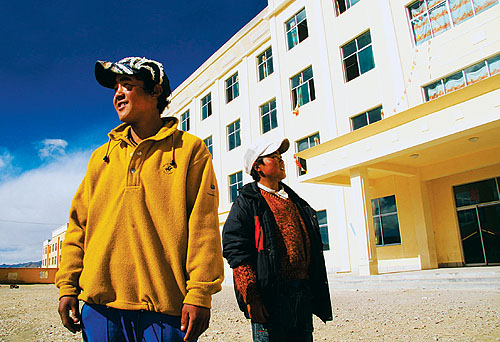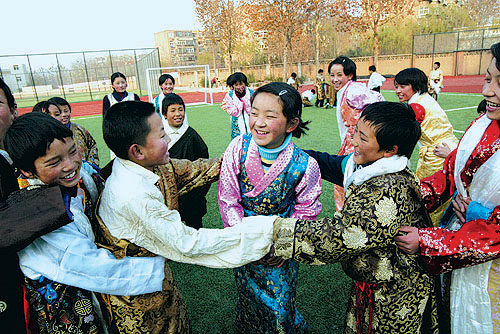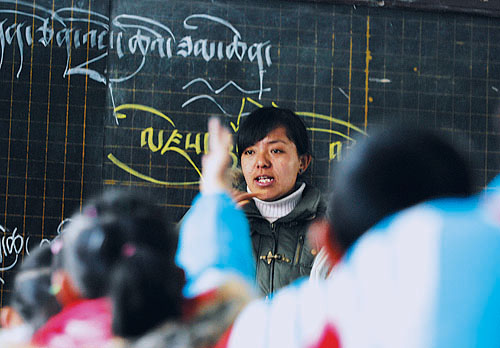|
 Tibetan students and their new campus.
Tibetan students and their new campus.
There wasn't even one formal school in the modern sense in all Tibet in the past. The illiteracy rate reached 95 percent and the school enrollment rate only two percent. Through the efforts of more than 50 years, a comparatively integrated education system, including preschool education, elementary and secondary education, higher education, vocational education, special education and adult education, has taken shape.
Tibet invested 3.276 billion Yuan in the development of the education undertaking in 2007, up by 22.34 percent over the previous year. The money mainly was used to improve the mechanism for ensuring continuing funding for rural compulsory education, cover the exemption of tuition and miscellaneous fees and textbook fees for urban students at the compulsory education stage, charge the free compulsory education and purchase teaching appliances and laboratory equipments fro the elementary and junior middle schools. Here are now 884 elementary schools and 1,237 teaching centers, with a total student body of 320,500 and an attendance rate of 98.2 percent for children of school age, a rise of 1.7 percentage points over the previous year; there were 117 regular high schools, with 135,900 junior high school students and 44,000 senior high school students; 10 secondary vocational schools, with a total student number of 18,958; and six institutions of higher learning such as Tibet Nationalities Institute, Tibet Agriculture and Animal Husbandry College, Tibet University and Tibet Institute of Tibetan Medicine, with 26,767 students. In recent decades, over 20,000 students have graduated from universities and more than 23,000 students from technical secondary schools, including a number of Tibetan doctors and masters. In addition, there are also large numbers of professional talents such as Tibetan scientists, engineers, professors, famous doctors, writers and artists.
Compulsory Education Popularization
 Students of the Jinan Tibetan School built by the Shandong and Jinan governments. Many similar schools have been built in inland China to train students hailing from the Tibetan-inhabited areas.
Students of the Jinan Tibetan School built by the Shandong and Jinan governments. Many similar schools have been built in inland China to train students hailing from the Tibetan-inhabited areas.
Tibet steadily pushes forward the popularization of compulsory education. From 2003 to the end 2007, some 437 standardization township or town elementary schools were constructed, and 93 junior schools were expanded. Some 74 counties of the TAR had popularized six-year compulsory education with the coverage rate reaching 100 percent; Some 63 counties had popularized nine-year compulsory education with the coverage rate reaching 90.2 percent; The coverage rate of the population becoming literate in 64 counties reached 90.4 percent; the illiteracy rate of young and middle-aged people was reduced from 39 percent in 2000 to 4.76 percent in 2007.
In 2007, the regional government invested 472 million Yuan in building 39 standardization township or town elementary schools and 13 junior schools. The region realized the goal of basically popularizing nine-year compulsory education, and basically eliminating illiteracy among young and middle-aged people, and raised the level of compulsory education popularization. The enrollment rates of elementary school, junior middle school, senior middle school, and institution of higher learning are 98.2 percent, 90.7 percent, 42.96 percent and 17.4 percent respectively.
From 1985, Tibet provided subsidies for the costs of food, accommodation and the education fees of students from the rural and pastoral families.
From the autumn in 2007, such subsidies were raised again. Of the total, the annual per capita subsidy provided for primary school pupils from the rural and pastoral families was increased to 1,200 Yuan from the original 1,100 Yuan, and that for students of junior high schools to 1,350 from 1,250 Yuan; with regard to students in border counties and townships, it is 1,300 Yuan for primary school pupils and 1,450 Yuan for junior high school students.
Teaching in Tibetan Language
 A shot of a Lhasa primary school. Tibetan language teaching is much emphasized in Tibet.
A shot of a Lhasa primary school. Tibetan language teaching is much emphasized in Tibet.
Currently, besides the elementary schools whose students are mainly of Han ethnic group in few cities and towns teaching in Chinese, most primary schools in rural and pastoral areas as well as the urban areas take Tibetan as one of the main subjects and courses are taught mainly in Tibetan. In the whole region, a total of 102 classes are taught in Tibetan language, as well as some courses in middle schools. Meanwhile, efforts are also being made to accelerate the teaching of the natural science in junior middle schools in Tibetan.
From 1985, the State opened Tibetan classes and schools in some 20 provinces and municipalities directly under the Central Government in the hinterland, ranging from junior middle school to university. Tibetan middle schools in the hinterland have always had Tibetan courses. By the end of 2007, there were all together 28 schools in the country running Tibetan classes, including 19 junior middle schools, seven senior high schools and two normal schools. A total of 53 inland senior high schools enrolled transfer students from Tibetan classes, and 90-plus higher schools admitted senior high school graduates from Tibetan classes. The Tibetan classes at junior high level enrolled 33,100 students accumulatively, and some 14,300 graduates returned to Tibet for its construction.
Tibetan is the major subject and one of the basic teaching languages of the schools at various levels and of diverse kinds. Efforts are being made constantly to improve the teaching contents and methods and raise teaching quality. From 1989, Tibet University successively ran classes for training would-be Tibetan teachers of junior high schools. Up to now, it has trained 1,438 such teachers and compiled and rewritten the teaching materials of 19 disciplines.
(China's Tibet facts and Figures 2008) |
